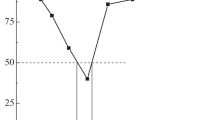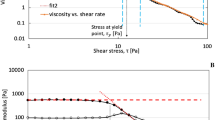Abstract
Spherical cellulose beads having narrow particle-size distribution were prepared by the coagulation/regeneration method for small viscose droplets formed by centrifugal force in an acid bath. The influences of chemical modifications on mechanical strengths such as the hydraulic property and compressive strength were investigated, together with the effects on crystallinity, particle size and degree of swelling. Cross-linking with epichlorohydrin and substitution of hydroxyl groups in cellulose with diethylaminoethyl, carboxymethyl and cyanoethyl groups were studied. No remarkable differences were found in X-ray diffraction patterns for the cellulose beads after the chemical modification. The substitution promoted swelling of the beads and decreased the mechanical strength, probably by scission of intermolecular and/or intramolecular hydrogen bonds in cellulose. However, the cross-linking retarded the cellulose beads from swelling effectively. The beads were made significantly ha rder by the substitution, and this hardening effect competed with the softening effect of the swelling. Moreover, it was suggested that the simple compression test was useful for the prediction of the hydraulic property of the cellulose beads in the column operation. 0969--0239 © 1998 Blackie Academic & Professional
Similar content being viewed by others
REFERENCES
Andrei, D. C., Briscoe, B. J., Luckham, P. F. and Williams, D. R. (1996) The deformation of microscopic gel particles. J. Chim. Phys. 93, 960–976.
Ant-Wuorinen, O. and Visapää, A. (1965) Determination of the state of order in cellulose by an improved X-ray diffractometric procedure. Pap. Puu. 47, 311–322.
Ball, M. and Harries, R. R. (1989) Resins for high-purity water production. J. Chem. Tech. Biotechnol. 45, 97–107.
Hebeish, A., Abd El-Thalouth, I., El-Kashouti, M. A. and Khalil, M. I. (1984) Chemical factors affecting soiling and soil release from cotton-containing durable press fabrics. Part XI. Cotton bearing carboxymethyl together with cyanoethyl groups. Acta Polym. 35, 170–175.
Horák, D., Hradil, J. and Benes, M. J. (1996) Packings for size exclusion chromatography: preparation and some properties. A. C. S. Symp. Ser. 635, 190–210.
Horito, H. (1993) Characteristics and advantages of uniform particle size ion-exchange resins. JETI 41, 86–88.
Inoue, T. (1989) A new freeze-drying method using organic solvents: the t-butyl alcohol freeze-drying method. Electron Microscopy 24, 226–229.
Kuga, S. (1984) Porous cellulose materials for liquid chromatography. Jpn. Tappi J. 38, 166–173.
Loth, F. and Philipp, B. (1989) The macroporous network of 'bead cellulose' and its response to crosslinking with epichlorohydrin. Makromol. Chem. Macromol. Symp. 30, 273–287.
Matsumoto, K. (1992) Development of porous spherical cellulose beads with large particle size. Function & Materials 12, 23–29.
Matsumoto, K., Hirayama, C. and Motozato, Y. (1981) Preparation of bead-shaped cellulosic ion exchangers. J. Chem. Soc. Jpn., Chem. Ind. Chem. No 12 1890–1898.
Motozato, Y. and Hirayama, C. (1984) Preparation and properties of cellulose spherical particles and their ion exchangers. J. Chromatogr. 298, 499–507.
Nelson, M. L. and O'Conner, R. T. (1964) Relation of certain infrared bands to crystallinity and crystal lattice type. Part II. A new infrared ratio for estimation of crystallinity in cellulose I and II. J. Appl. Polym. Sci. 8, 1325–1341.
Peška, J., Štamberg, J. and Hradil, J. (1976) Chemical transformations of polymers. XIX. Ion exchange derivatives of bead cellulose. Angew. Makromol. Chem. 53, 73–80.
Philipp, B. (1979) Heterogenreaktion der Cellulose—einige Ergebnisse und offene Probleme. Z. Chem. 19, 433–441.
Saito, K., Hosoi, F., Makuuchi, K. and Koishi, M. (1986) Enhancement of aspirin capsulation by porous particles including iron hydrous oxide. Koubunshi Ronbunshu 43, 51–58.
Segal, L., Creely, J. J., Martin, Jr, A. E. and Conrad, C. M. (1959) An empirical method for estimating the degree of crystallinity of native cellulose using the X-ray diffractometer. Text. Res. J. 29, 786–794.
Suzuki, K. (1994) Functional papers derived from chemically modified cellulose fibers. Jpn. Tappi J. 48, 763–771.
Titcombe, L. A., Bremner, J. B., Burgar, M. I., Ridd, M. J., French, J. and Maddern, K. N. (1989) Evaluation of chemically modified cellulose from cotton linters. Appita J. 42, 282–286.
Westman, L. and Lindström, T. (1981) Swelling and mechanical properties of cellulose hydrogels. I. preparation, characterization, and swelling behaviour. J. Appl. Polym. Sci. 26, 2519–2532.
Author information
Authors and Affiliations
Rights and permissions
About this article
Cite this article
ISHIMURA, D., MORIMOTO, Y. & SAITO, H. Influences of chemical modifications on the mechanical strength of cellulose beads. Cellulose 5, 135–151 (1998). https://doi.org/10.1023/A:1009277216057
Issue Date:
DOI: https://doi.org/10.1023/A:1009277216057




